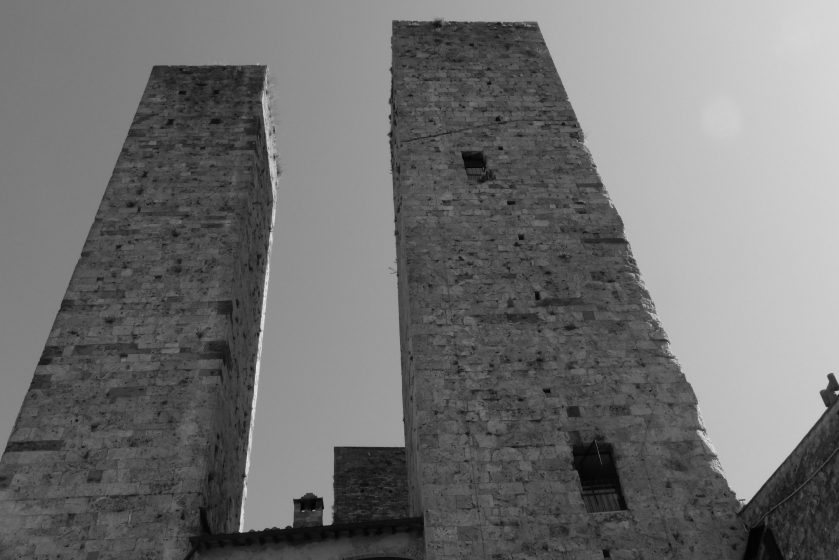
We pulled into the small parking area at the Porta San Giovanni before ten in the morning. I made a quick beeline up the main street, wasting no time viewing the celebrated frescoes at the Collegiata or climbing the town’s medieval towers, in my haste to reach the opposite Porta San Mateo, where I finally arrived at my destination: San Gimignano’s barbershop.
Two elderly gentlemen made room on an upholstered banquette, and I waited my turn. I had plenty of time to look around and take the measure of my man. Juventus was his club, Ferrari his automobile. A tall vitrine near the front of his shop, filled with model cars, most of them red — the Italian racing colour. On the counter, a wooden case lined with red velvet and containing a collection of scissors. (There were 48; I had time to count.) On the walls, photos of grandkids, including of a little girl in a tutu, caricatures, the heads of well-barbered local celebrities, framed prints and sketches of the region, a yellowing diploma.
But then, near the back, beside the hair-washing sink, a large black-and-white photo of Che Guevara. Then the famous image of the martyred Che in his coffin. Then Che playing chess, Che being charming, Che being Che. Fidel was there, too. I think I recognized Antonio Gramsci, the Marxist theoretician Mussolini hounded to death. Plus a mustachioed long-ago signore I took for Garibaldi. Plus several black-and-white others I couldn’t identify.
My barber possessed not a word of English, but when it was my turn I pointed to his shrine and said “Che!” Shamelessly, I raised my right fist.
He immediately clapped me on the back and motioned me to sit.

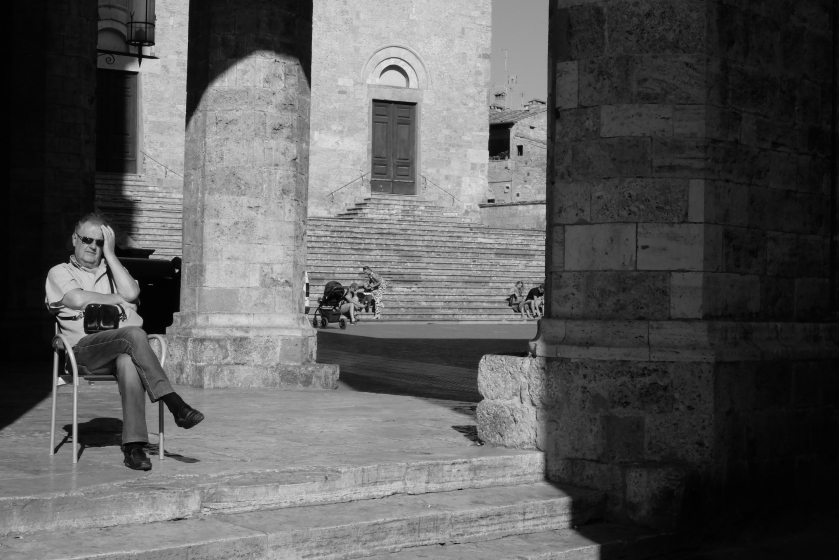
Left turn in Italy
My barber wore immaculate white trousers and white clogs, as well as a white tunic with red panels on the front. Communism is still hanging on in Italy, as it does in Greece. (You wonder what they hope for.) Mysteriously, encouragingly, it thrives alongside other practices long-since discredited in large parts of North America, such as sausage making and smoking.
I grew up surrounded by professed Greek Communists, so I know that the colour red is a fashion item, a team colour and a vestment. Black, worn by the opposite team and denoting Fascism, was to be avoided. So were crowns, thrones, priests and millionaires driving Ferraris.
Some days ago, in Certaldo’s Piazza Boccaccio, I saw a poster of a smiling woman promoting a Communist rally. It’s been years since I’d seen a hammer and sickle that wasn’t an ironic declaration on a hipster t-shirt. My San Gimignano barber had a similar poster outside his shop. In Volterra, we peeked inside a historic syndicalist café, nearly empty at the time, where the TV was tuned to a soccer game no one was watching.
Red is the colour of Ferrari but also the colour of Che. So it makes some sense, but also no sense at all.
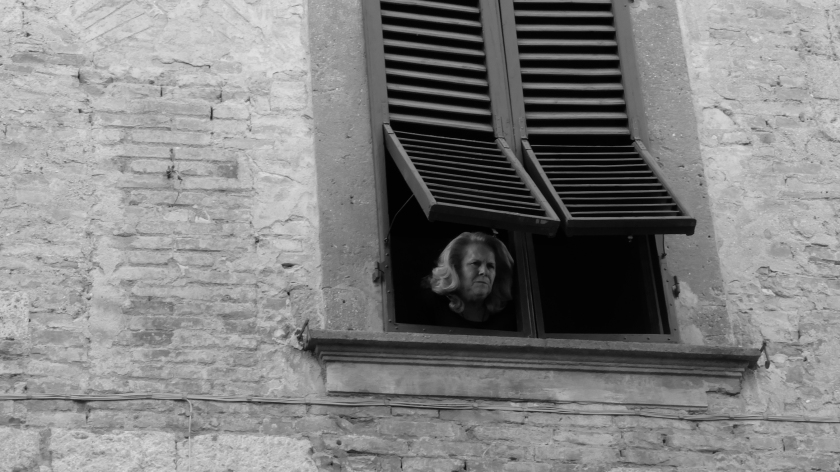
Saint Fina
Later in the day, with another haircut in the books, we visited the Basilica of Santa Maria Assunta, better known as the Collegiata. The large, plain-fronted church is misleading, because it houses a stunning interior — three tiers of floor-to-ceiling and wall-to-wall frescoes crowded with stories from the Old and New Testaments. Heaven and hell, Adam and Eve, Noah and his ark, Christ and his betrayers. There’s a fantastic and frightening vision of hell, high up on the wall, and I kicked myself for leaving my binoculars back at the agriturismo.
Attributed to Ghirlandaio and his school, the paintings retain their fresh colours and a vivid, familiar humanity: the fellow pouring your wine, the kids roller skating the piazza, the pensioner feeding the pigeons — they’re all here. Scenes of tender beauty and faith, but also scenes of savage violence. Swords lop off heads, saints bristle with arrows, lances pierce the flesh of innocents; and from the flesh, rivers of blood. A Christianity of martyrdom, of patient suffering and final redemption. A Christianity of calculated spectacle and narrow instruction.
Opposite the entrance, there’s a small chapel dedicated to San Gimignano’s own Saint Fina. At the age of ten, Saint Fina fell ill with a mysterious disease that caused her to be paralyzed and covered with sores, and to spend the next five years lying on a rough wooden plank. She eventually died, but her patience and fortitude transmitted to visitors “the merits of the Lord’s Passion.” At the moment of her death, on March 12, 1253, the bells of San Gimignano rang out joyously without any apparent human intervention. Today, in that small chapel, you can view the rough plank that served as her sick bed.
There’s also a painting of Saint Gregory, surrounded by angels, announcing to Saint Fina her approaching death. Lying on her saintly plank, her hair is beautiful.
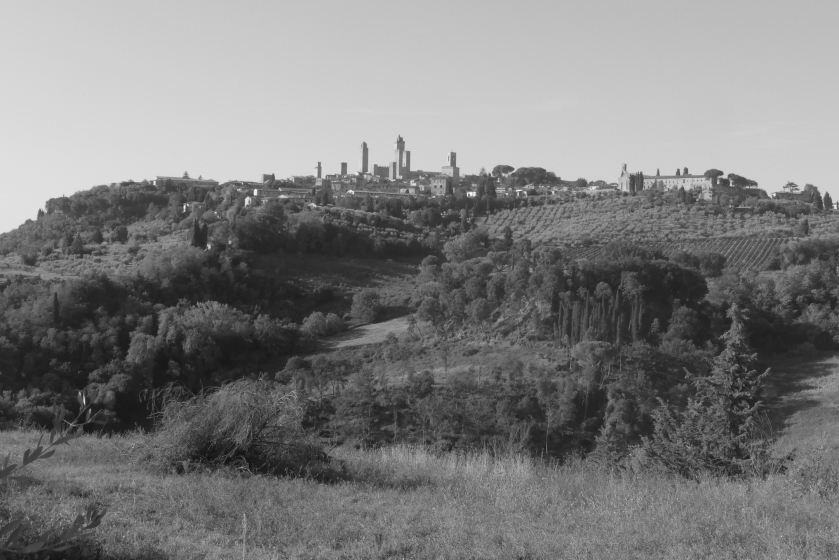
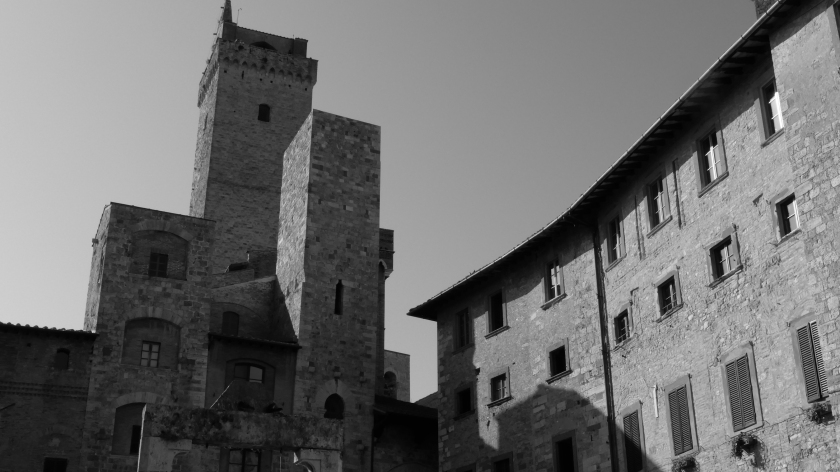
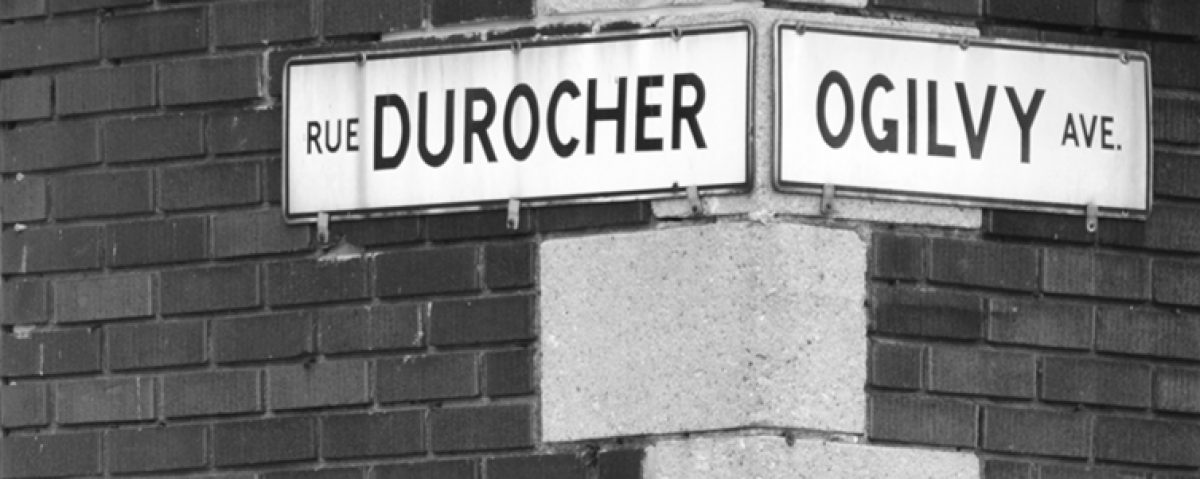
Dear Spyro,
I look forward to seeing, “because i said” in my inbox. You entertain and enlighten me each time. Plus, sometimes, we have visited the same places and you bring back great memories! Thank you.
Mike
PS: Superb pictures!
LikeLike
Thank you, Mike! I look forward to seeing you and the lovely Joanne when we return. Kisses!
LikeLike
Sorry: “Johanne.”
LikeLike
That is an impressive collection of scissors. I’m not surprised that you counted them. I too have had my hair needs tended to in places where conversation is not an option. In fact, I seek them out. Invariably, there is never a shortage of entertaining diversions in these hubs of humanity. Thanks for writing.
LikeLike
Yes, the barbershop is the place to be. If you recall, I had another wonderful encounter with a barber in Porto. Thanks for reading.
LikeLike
Hilarious and informative and entertaining! I especially love the photo of the Collegiata and the woman in the window.
The fact that there were over 70 towers at one point is truly remarkable. Families one-upping each other and also using the towers to throw things at each other, I think? It was years ago that I was there, memories are fading a bit.
LikeLike
Thanks, Alison. Yes, families throwing rocks and boiling oil at each other. We have a similar phenomenon in the Mani region of Greece. Many extant towers.
LikeLike